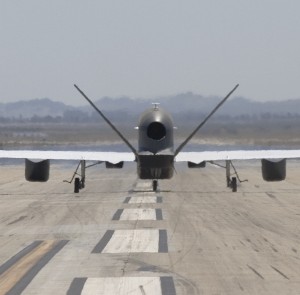U-2 cameras on Global Hawks? — some like the idea
The rap against the Block 30 versions of the Global Hawks has been that they can't steer around typhoons, and their cameras lack the range of those on the traditionally-piloted U-2 planes.
So why not move Senior Year Electro-optical Reconnaissance Systems off the U-2s and onto the Block 30s and upgrade the planes to avoid or cope with severe weather?
Northrop outlined those ideas in Feb. 8 letter from CEO Wes Bush to the Air Force brass. The company has taken a lot of heat for cost overruns on the Global Hawk program, and this time it says it's willing to do the work under firm-fixed-price contracts.
For $48 million, Northrop says it can equip six of the service’s 18 Block 30 Global Hawks with existing SYERS-2A cameras. For $7 million more, it can equip three of the planes with a solution for the weather problem. Northrop would accept the same $258 million a year to keep the planes flying, even if the contract length were cut back from 10 years to five.
The Northrop proposal is the latest volley in the company’s battle to save the Block 30 planes from the Air Force’s budget knife. The Air Force says it wants nothing to do with the Block 30s after 2014, because of their troubled history, and the fact that the Pentagon has scaled back its official requirement for spying from high-altitude aircraft.
Neither the Global Hawks nor the U-2s can do what the intelligence community really needs them to do, which is peer deep inside Iran, an Air Force official said. The only solution for that would be “National Technical Means” – a euphemism for spy satellites -- the official said.
Nevertheless, Northrop’s proposal to improve the Block 30s is getting traction on Capitol Hill, judging by an April 12 congressional hearing.
“I personally believe that there are common sense improvements that enhance the Block 30 utility,” said Rep. Madeleine Bordallo, a Democrat from Guam, where Global Hawks are flown from. She was seconded later by Rep. Rob Bishop, R-Utah, who advocates continuing to fly both the U-2s and Global Hawks.
The reception from the Air Force was less than warm: “This remains a difficult area,” Air Force Secretary Michael Donley responded.
Behind the scenes, Northrop has been working to build support among lawmakers, their staffs, and Air Combat Command. “That’s fine, that’s what they do,” an Air Force official. “It hasn’t changed the position of the Air Force yet.”
Some lawmakers were flabbergasted in January 2012, when the Air Force did an about-face and said it wanted to cancel the Block 30 program and put the planes in storage. Only months earlier, the Pentagon had re-certified the over-budget planes as critical to national security, a requirement for continued funding under the Nunn-McCurdy cost control law.




Ben, remember what I mentioned to you at the AUVSI DC chapter meeting….physics does not allow Global Hawk to do what the U-2 can do. The aggregate capabiolities of the U-2 eclipse the Global Hawk.
chuck